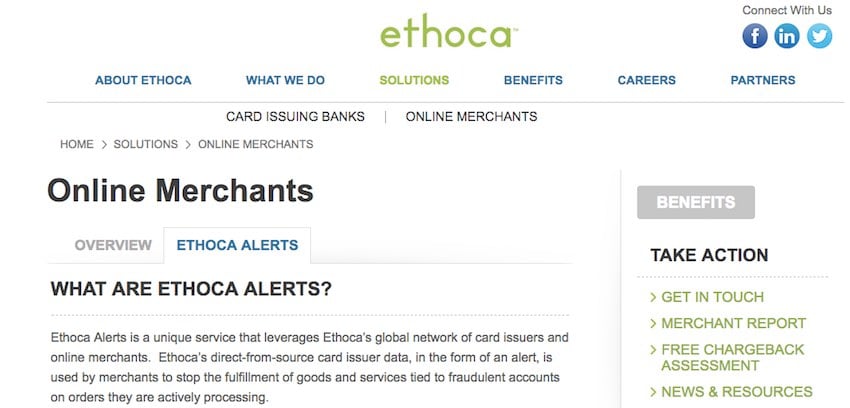
Credit card chargebacks plague most ecommerce companies. There are steps that merchants can take, however, to reduce chargeback risk. One is using a third-party service, such as Ethoca, that connects data from card issuers and online merchants to reduce fraudulent orders, and fraudulent chargebacks.
Credit card chargebacks — wherein shoppers purchase products with a credit card and then contest the charge from the credit card issuer — are an always-present threat to ecommerce merchants.
In this post, I’ll describe four ways that merchants can ease the burden of chargebacks.
4 Ways to Reduce Credit Card Chargebacks
Streamline shipping operations. Fast shipping is important for all merchants, but especially for direct marketers, infomercial merchants, network marketers, and multilevel marketers. Purchasing from these companies is largely impulse-driven, driven by attention-grabbing ads. So making a customer wait to receive his items can increase return and chargeback rates.
Decrease your time to ship and you’ll decrease the amount of time you give customers to change their minds. It’s that simple. A product that takes weeks to ship will typically experience more chargebacks.
Alternatively, merchants that offer same-day shipping or next- or two-day shipping see fewer chargebacks, usually. These merchants discovered what should be obvious: Give customers what they want, when they want it. Customers want the item when they place the order, not weeks later.
Emphasize customer service. Ecommerce is increasingly competitive. Shopping cart platforms are inexpensive and sophisticated, facilitating thousands of new sellers. It’s customer service that often separates the successful sellers.
The days of automated voicemail systems or simply listing frequently asked questions on an ecommerce site are over. Shoppers expect to speak to a live person who can answer their questions adequately and quickly. Merchants should offer live, always-on support. The more service and support, the fewer purchasing mistakes by shoppers, who could then initiate chargebacks.
Boosting customer service capabilities may require an investment, but the long-term results of lower chargebacks and higher revenue can be worth it.
Simplify cancellations and returns. It might seem counterintuitive, but providing a straightforward cancellation and return policy helps avoid chargebacks, and the fines and fees that accompany them. Returns are less expensive than chargebacks, in other words.
Consider the following steps to minimize returns and cancellations:
- Have a clear, concise, and easy-to-follow policy for what can be returned (or cancelled) and the process for doing it.
- Do not harass customers who want to return products. Train your customer service reps to be polite and accommodating, and to avoid high-pressure tactics to dissuade customers from completing the return or cancellation.
- Prominently display your return and cancellation policy on your website and on the invoice that is shipped with the product.
Use fraud prevention tools. Sometimes chargebacks are the result of true fraud, where criminals use fraudulently obtained credit card information to make a purchase. Guard against fraudulent chargebacks with a suite of customized fraud prevention tools that make sense for your business.
Fraud prevention tools can vary among merchants. They are not one-size-fits-all. Merchants can work with their payment processor or other advisor to discover the best combination of tools for their business.
These tools could include:
- Anti-fraud databases. These databases alert merchants of (a) suspicious ordering activity triggered by botnets — a network of malicious computers, (b) credit card numbers that have been associated with past fraud, (c) rapid orders with multiple credit card numbers, and (d) geographical inconsistencies with the computer used for purchase and where the user claims to be.
- Chargeback notifications. Some solution providers, such as Verifi and others, offer alerts or notifications when a chargeback is initiated, giving the merchant time to resolve the dispute with the cardholder rather than navigating through the convoluted chargeback process.
- Card security codes. By validating the card security code (the 3 digits on the back of Visa, Mastercard, and Discover cards and the 4 digits on the front of American Express cards), merchants can help verify that the person making the order is in physical possession of the credit card.
